
* The Hunter went through a troubled adolescence but eventually became an excellent machine, and the basic design was modified into a large and somewhat confusing number of variants. This chapter discusses the origins and development of the Hunter and describes the major variants.
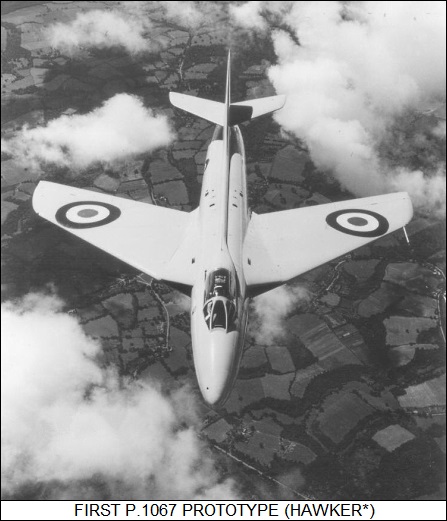
* By the end of World War II, Hawker Aviation and the company's chief designer, Sydney Camm, knew that jet fighters were the future. Camm's first effort along this line was a jet derivative of the Fury piston fighter, known as the "P.1040". Two P.1040s were built as demonstrators using company funds. Although the RAF wasn't interested, the type went into Royal Navy Fleet Air Arm (FAA) service as the neat little Hawker "Sea Hawk" naval fighter. The Sea Hawk was slightly longer and had a wider span than the P.1040; of course it also featured armament, arresting hook, and other operational kit not fitted to the P.1040.
The Sea Hawk served the Royal Navy and a few foreign air services competently through the 1950s, but it was basically a first-generation jet fighter design, with straight wings and a Rolls-Royce Nene centrifugal-flow turbojet engine. Swept wings were clearly the way of the future, but although swept wings clearly meant greater speed, they also meant low-speed handling peculiarities that had to be investigated in detail. As a result, the P.1040 design led to the experimental swept-wing "P.1052", developed to meet British Air Ministry specification "E.38/46".
The first P.1052 first flew in December 1948. It was almost identical to the P.1040, except for wings with 35-degree sweepback and a slightly modified tail. It retained the Nene engine and the interesting split-exhaust scheme of the P.1040 -- where instead of a single exhaust in the tail, there was an exhaust at the rear root of each wing. Two P.1052s were built and used for tests into the early 1950s, with the first prototype fitted with arresting gear along with other navalized kit and used to investigate operation of swept-wing aircraft off carriers.
The P.1052 demonstrated good speed performance, reaching 1,050 KPH (650 MPH) in level flight. Hawker felt that with some changes it might actually make a good operational fighter, and came up with a modified version designated the "P.1081", funded as a private venture.
A single P.1081 was built as a conversion of the second P.1052 prototype. It looked much the same as the P.1052 from the wings forward, but it had a new rear fuselage, with a single exhaust in the tail and an all-swept tailplane. The single exhaust scheme was chosen because the expectation was that an afterburning derivative of the Nene named the "Tay" would be fitted later in trials, and a split exhaust scheme made fit of an afterburner very troublesome. The P.1081 was intended to be armed with four Hispano Mark V 20-millimeter cannon in the nose and had provisions for underwing drop tanks. The P.1081 prototype first flew on 19 June 1950.
___________________________________________________________________
HAWKER P.1081:
___________________________________________________________________
wingspan:
9.60 meters (31 feet 6 inches)
wing area:
23.97 sq_meters (258 sq_feet)
length:
21.38 meters (37 feet 4 inches)
height:
4.04 meters (13 feet 3 inches)
empty weight:
5,080 kilograms (11,200 pounds)
loaded weight:
6,568 kilograms (14,480 pounds)
max speed, sea level:
1,120 KPH (695 MPH / 605 KT)
___________________________________________________________________
There was consideration of producing the P.1081 for the Royal Australian Air Force, but the RAAF didn't follow up. The prototype was lost in a crash on 3 April 1951. It seems a bit of a pity in hindsight that the P.1081 didn't enter production, since it was apparently competitive in performance with the US North American F-86 Sabre, and was clearly better-armed. It would have been interesting to see what it could have done against Soviet MiG-15s in Korea.
* The P.1081 went nowhere as an operational aircraft, but it gave Hawker useful ideas for a bigger and better machine, with some similarities in design but a more powerful axial-flow turbojet engine.
In January 1946, the Air Ministry had issued a specification designated "F.43/46" for a new jet-powered daylight interceptor. In January 1948, Sydney Camm and his design team responded with the "P.1067", a swept-wing fighter design that was to be powered by the new Rolls-Royce "Axial Jet 65 (AJ.65)", later the Rolls-Royce RA.5 Avon, with 28.9 kN (2,950 kgp / 6,500 lbf) thrust.
The original P.1067 concept featured an oval intake in the nose; a tee tail; and armament of four Hispano Mark V 20-millimeter cannon, with two in the nose and one in each wing root, or alternatively two 30-millimeter Aden revolver-type cannon. An unguided rocket pack and new British guided air-to-air missiles (AAM) then in development were also considered as armament options.
The Air Ministry liked the concept, and in March 1948 issued a new specification, designated "F.3/48", to cover the project. The concept mutated during development, with increase in the kit that had to be fitted in the forward fuselage forcing the relocation of the intakes to the wingroots; concerns over the effectiveness of the tee tail leading to adoption of a conventional swept tail assembly; and selection of more powerful armament, in the form of four 30-millimeter Aden cannon.
The wing had a sweep of 35 degrees and a slight anhedral droop. Control surfaces were entirely conventional, with ailerons, elevators, and rudder, plus flaps inboard of the ailerons. The aircraft was of conventional all-metal monocoque construction. It was built in five major assemblies, include front fuselage, center fuselage, rear fuselage with tail unit, and wing assemblies. The rear fuselage could be unbolted and pulled off for engine maintenance.
The cannon were to be fitted in a pack that dropped out of the fuselage. Interestingly, the barrels remained in the nose to make the pack easier to handle and install. Leaving the barrels in the aircraft seems like an unusual measure, but it is demonstrated in photographs of ground crew removing the pack. The mechanism by which the barrels were attached to the pack once it was installed sounds interesting, but specifics are unclear. In any case, the pack contained all ammunition and in principle allowed quick turnaround of a fighter between combat sorties. The ammunition store was 135 rounds per gun, which only permitted a total of seven seconds firing time, though the pilot could fire the cannon by pairs to preserve ammunition. Some sources claim the store was 150 rounds per gun, but this appears to be the maximum capacity and not the practical load. A ranging radar was to be fitted in the nose.
Although the revised design retained the Avon engine, as insurance against Avon development problems the P.1067 was designed to accommodate another new British axial-flow turbojet, the Armstrong Siddeley Sapphire. The P.1067 also featured tricycle landing gear with a comfortably wide track, all with single wheels, with the nose gear retracting forward and the main gear hinged in the wings to retract inward. The canopy slid backwards over the fuselage spine to open.
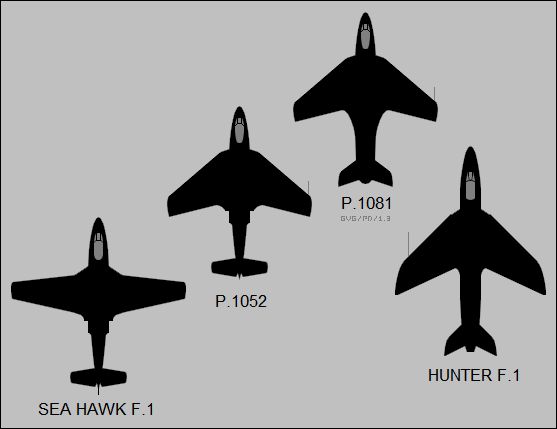
The end design ended up looking something like a scaled-up and stretched version of the P.1081, though the P.1067 really wasn't so much a direct descendant of the P.1081, so much as it incorporated some of the same thinking. The first of three P.1067 prototypes performed its initial flight from the Aeroplane & Armament Experimental Establishment at Boscombe Down on 20 July 1951, with test pilot Neville Duke at the controls. This machine was powered by an Avon 103 engine, leveraged from the English Electric Canberra twin-engine bomber, providing only a modest 28.91 kN (2,950 kgp / 6,500 lbf) thrust.
The first prototype was unarmed and lacked most operational kit, but the second prototype was close to production standard, fitted with armament and the ranging radar, as well as an RA.4 Avon 107 engine with 33.58 kN (3,425 kgp / 7,550 lbf) thrust. The second prototype performed its first flight on 5 May 1952.
The third prototype was fitted with an Sa.6 Sapphire 101 turbojet with 35.6 kN (3,630 kgp / 8,000 lbf) thrust instead of the Avon, and performed its first flight on 30 November 1952. The two Avon-powered prototypes were painted in a pleasant if definitely un-military pastel duck-egg green, while the Sapphire-powered prototype was painted in RAF "Speed Silver". Although the original proposal for the machine's name had been "Demon", the US McDonnell company had just unveiled a naval fighter of that name, and so the alternate name of "Hunter" was selected instead.
BACK_TO_TOP* In March 1950, even before the initial flight of the first P.1067 prototype, the British Ministry of Supply (MoS) had ordered an initial batch of production machines. The first production "Hunter Fighter Mark 1 (F.1)", as it was designated, performed its initial flight on 16 May 1953. The F.1 was powered by the RA.7 Avon Mark 113 turbojet, with 33.80 kN (3,450 kgp / 7,600 lbf) thrust.
The first 20 F.1s built were basically trials and evaluation machines. They weren't manufactured to an entirely uniform specification, and they were modified in various different ways to test out new features -- such as a "blown flaps" scheme to reduce take-off roll, and even a revised rear fuselage to test out "area ruling", in which transonic handling was to be improved by minimizing changes in aircraft cross-section, meaning the fuselage bulged out at the rear of the wing.
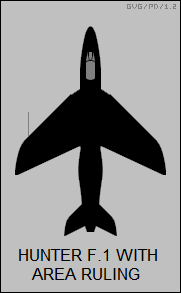
Even the full-production F.1s weren't really operational machines. It would be nice to say that the Hunter was seen as a winner from day one and it was certainly played up as one by the publicity mill, but in reality plenty of work needed to be done to turn the Hunter into an effective combat aircraft. Had the RAF realized what they were in for, the service might have been more interested in acquiring the P.1081 as an interim fighter.
The most glaring problem was that the type's internal fuel capacity was much too small, giving it minimal endurance. That was a common problem with first- and second-generation combat jets. There were subtler problems as well. There was a mismatch between engine inlet design and engine air requirements that led to surges and other problems. Another issue was that the Hunter originally used split flaps for air brakes, but that led to nasty pitch-down problems, as did air brakes along each side of the rear fuselage. A ventral airbrake was introduced in the 19th F.1 that was much more satisfactory -- except for the fact that it couldn't be used on landings, and so it was automatically disabled when the landing gear were extended.
A major problem was that at high altitudes firing the cannons also tended to cause engine surges and flameouts. All that could be done was install a modification that cut fuel to the engine when the cannon were fired, which coupled to the cannons' heavy recoil caused the nose to pitch down at high altitude. Even with this fix, cannon firing was restricted to low altitude and speed -- not exactly convenient for an aircraft designed for the air combat role.
Another problem was that discarded cannon ammunition belt links tended to strike back against the rear fuselage and tail, tearing them up. In addition, the canopy tended to mist and ice badly during descents, sometimes completely blinding the pilot. By modern standards the cockpit was something of an ergonomic disaster, but in those days hardly anybody knew what the word "ergonomics" meant; pilots were used to that sort of thing, and in comparison to the other RAF fighters they had flown, the cockpit was reasonably laid out and relatively roomy. The cockpit layout would never be seriously changed.
A total of 113 F.1s was built at the Hawkers Kingston plant, with another batch of 26 built at the Blackpool plant, for a total of 139. In RAF service the F.1s were painted with a disruptive camouflage pattern of dark green and dark sea gray on top, with silver on the bottom, though the silver would be quickly replaced by light gray. This scheme would be more or less standard for the rest of the Hunter's career in RAF service, and would be adopted by a number of the many other air arms that flew the type.
The Avon-powered Hunter F.1 was followed by the "F.2", which was powered by the Armstrong Siddeley Sapphire 101 turbojet with 35.6 kN (3,630 kgp / 8,000 lbf) afterburning thrust. Initial flight of the first F.2 was on 14 October 1953. The Sapphire had few problems with gun gas ingestion and better fuel economy than the Avon, but only 45 Hunter F.2s were built.
Both the F.1 and F.2 had short operational lives since they were really not suitable for front-line service. The Hunter had been rushed into full production as a "Super Priority" program, meaning the aircraft was to be put into service as quickly as possible, hang the bugs; problems were to be fixed as production went along.
The minimal fuel supply of the F.1 and F.2 was really the worst problem, since they had a flight endurance of an hour at most. 37 F.1s and 5 F.2s were lost in accidents, with simply running out of fuel being one of the main contributors to the high accident rate. Six F.1s were lost in this way in a single incident on 8 February 1956 when a flight of eight Hunters was forced to divert to a different airfield due to bad weather. Four pilots ejected safely; one managed to dead-stick his Hunter back down; the sixth wasn't so lucky, going into the ground with his machine. Two of the eight Hunters did manage to land safely, though one ran out of fuel while taxiing.
On the plus side, the Hunter's performance was excellent, it handled beautifully, and it was very rugged. Breaking Mach 1 in a dive was easy; the aircraft took it in stride. Pilots also liked its new Martin Baker Mark 2H ejection seat, which was a marvel for the time. It was not in a league with a modern "zero-zero (zero-speed zero-altitude)" ejection seat, but it could be used safely at unprecedentedly low altitudes.
Pilots had few doubts that once the bugs were worked out with the Hunter, they would have a superb machine on their hands, all the more so because it simply looked right -- it was a classic example of British aircraft design philosophy, all smooth curves and pleasing lines. Besides, the only alternative the RAF had at the time was the Supermarine Swift fighter, which was proving a real problem child.
* In 1953, the initial Hunter prototype was fitted with an afterburning version of the Avon, the RA.7R, with 31.7 kN (3,234 kgp / 7,130 lbf) dry thrust and 42.7 kN (4,355 kgp / 9,600 lbf) afterburning thrust. The aircraft was also modified with a pointed nose, a curved windscreen, and an airbrake along each side of the rear fuselage; then painted a polished gloss red.
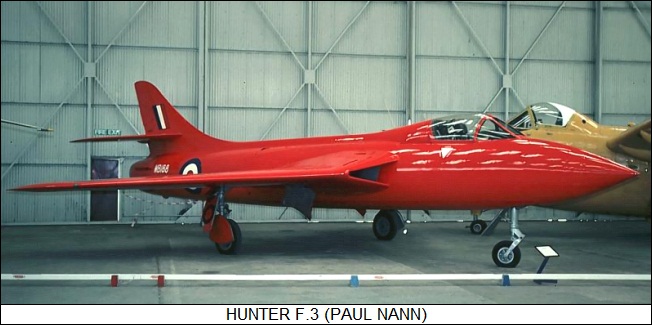
This was the sole "Hunter Mark 3". On 7 September 1953, it was used to set a world speed record of 1,163.2 KPH (722.2 MPH) over a 3 kilometer (1.86 mile) course, with Neville Duke at the controls. The F.3 was used as a ground instructional airframe for a time, then as a gate guard -- to finally end up as an exhibit in the museum at RAF Cosford, where it was restored to its appearance as a record-breaker.
BACK_TO_TOP* As mentioned, the Hunter was put into service very quickly, with fixes to be added as they became available. The first problem to deal with was of course the limited fuel capacity, and so a new wing was designed that featured fuel bags built into the leading edge. This increased fuel capacity from 1,533 liters (337 Imperial gallons / 404 US gallons) to 1,883 liters (414 Imperial gallons / 497 US gallons). The new wing also featured a stores pylon outboard of the main landing gear under each wing to carry a 454-liter (100 Imperial gallon / 120 US gallon) external tank.
The modified wing was fitted to the 114th F.1 in Kingston production, resulting in the very first "Hunter F.4". It performed its initial flight on 20 October 1954. Service deliveries of the F.4 began in March 1955, with 173 at built Kingston and 176 built at Blackpool for a total of 349, including the prototype. 20 RAF squadrons were equipped with the type at its peak.
The surge problem was to be partly addressed with an improved engine, the RA.15 Avon Mark 115, though the first 157 F.4s were built with the Mark 113 engine of the Hunter F.1; most of these 157 early-production machines were delivered to storage and then re-engined with the Mark 115 when it became available. The Mark 115 was an improvement as far as the surge problem went, but the fuel supply was still cut when the cannon were fired. Final production featured the RA.21 Avon Mark 21 engine.
The mounting for the cannon pack was reinforced, since early on the Hunter demonstrated some stress and cracking from the cannon recoil, and an air scoop was added in the nose that popped open while the cannon were being fired to flush out any potentially explosive buildup of muzzle gases. Many F.4s were modified with two blisters under the fuselage just forward of the engine intakes to collect the cannon ammunition belt links and prevent them from chopping up the tail. The cannon shells continued to be discarded, since they were heavy enough to fall away from the aircraft. The "Sabrinas", as they were named -- in honor of busty British pinup girl / starlet Norma Sykes AKA Sabrina -- were also retrofitted to some earlier Hunters.
* A version of the F.4 featuring the Sapphire 101 engine was produced as the "Hunter F.5", with a total of 105 built and five RAF Fighter Command squadrons equipped with the type. Despite the fact that the F.5 was generally superior to the F.4, the F.5 was the last Hunter to feature Sapphire power. That was apparently because the RAF used the Avon on other aircraft, such as the Canberra, and wanted to commit to a more or less common engine type to simplify logistics and maintenance, even if it took some bother to get the Avon working properly.
* Although the F.4 and F.5 were much more satisfactory than early Hunter versions, there was still room for improvement. Of course, the Avon engine remained a particular weak point. Rolls-Royce was determined to get the engine working right and came up with an improved version, the Avon 200; it featured a new compressor with 15 stages, with the first four stages copied from the Sapphire.
The Avon 200 provided 30% more power, but to the embarrassment of Rolls it was just as sensitive to surges as its predecessor. The company's engineers went back to the drawing board and introduced a new automatic fuel system and an improved throttle system that finally put the surging problems down, resulting in the RA.28 Avon 203, with 44.5 kN (4,536 kgp / 10,000 lbf) thrust. Fitting it to the Hunter resulted in the "P.1099" or "Hunter F.6", which finally achieved the type's potential. First flight of the F.6 prototype was on 22 January 1954.
The more powerful engine led to pitch-up problems, and so the area of the outer wings was increased, resulting in the introduction of a distinctive leading-edge "dogtooth". The new wing, known as the "Mod 228" wing, could be fitted with an outer "wet" stores pylon on each wing to allow the F.6 to carry a total of four external tanks. Early Hunter F.6 production used the older F.4 wing pattern, but all were eventually retrofitted with the Mod 228 wing, as were a handful of F.4s.
Although the F.6's internal fuel tankage was rearranged to provide a total internal capacity of 1,770 liters (390 Imperial gallons / 467 US gallons), 6% less than that of the F.4, the ability to carry four drop tanks provided substantially greater range. In 1958, one F.6 flew from the UK to Libya nonstop, a distance of 2,556 kilometers (1,588 miles).
___________________________________________________________________
HAWKER HUNTER F.6:
___________________________________________________________________
wingspan:
10.26 meters (33 feet 8 inches)
wing area:
31.59 sq_meters (340 sq_feet)
length:
13.99 meters (45 feet 10 inches)
height:
4.01 meters (13 feet 2 inches)
empty weight:
5,747 kilograms (12,670 pounds)
MTO weight:
10,885 kilograms (24,000 pounds)
max speed at altitude:
1,145 KPH (710 MPH / 620 KT)
service ceiling:
15,700 meters (51,500 feet)
range with tanks:
2,960 kilometers (1,840 MI / 1,600 NMI)
___________________________________________________________________
The F.6 also featured a Plessey Isopropyl Nitrate (AVPIN) engine starter system replacing the pyrotechnic cartridge starter system of earlier variants. The AVPIN starter system was not very successful. It was supposed to eliminate the reliance of the Hunter on starter cartridges, but the onboard store of isopropyl nitrate was too small to allow more than a few starting attempts, while the stuff was nasty, corrosive, and explosively unstable. Many pilots regarded AVPIN as a backward step.
Blast deflectors were later added to the Aden cannon muzzle troughs to reduce high-altitude pitch-up problems caused by cannon recoil, and late-production F.6s also featured an "all-moving tailplane", in which the entire tailplane pivoted to provide better transonic flight control. The elevator was retained as part of the all-moving tailplane.
* The F.6 prototype was followed by seven evaluation machines, all with the F.4 wing. The F.6 was introduced into RAF service in October 1956 and 384 were built for the RAF, including the prototype and evaluation machines, with 265 built by Hawker at Kingston and 119 by Armstrong Whitworth. The last F.6 built for the RAF performed its initial flight on 9 July 1957. The F.6 didn't have a long service career as an interceptor, being replaced by the English Electric Lightning in 1961.
BACK_TO_TOP* After the entry of the Hunter F.1 into service, Hawker began to consider a two-seat trainer version to replace increasingly antiquated Gloster Meteor and de Havilland Vampire two-seat trainers. The Hunter trainer project was given the company designation of "P.1101" and was initially conducted with company funds. The RAF did become interested in the idea, feeling it had potential for advanced and conversion training, and in 1954 issued a requirement designated "T.157D" written around the company's P.1101 concept.
The company developed concepts for tandem-seat and side-by-side-seating Hunter trainers. The RAF settled on side-by-side seating, since it gave the instructor a view comparable to the student's and closer supervision of the student -- the limitation being that the cockpit environment was very different from that which the student would encounter once going on to an operational fighter. The selection was something of a matter of fashion: in the modern day, side-by-side seating is generally regarded as appropriate for basic flight instruction, while tandem seating is seen as better for more advanced training roles.
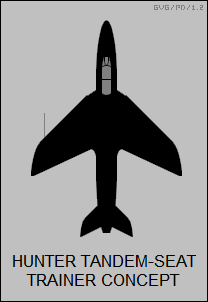
An initial mockup of the side-by-side version was assembled in early 1955, originally with a merged-bubble canopy that proved aerodynamically troublesome in wind-tunnel tests. It was replaced with a much simpler one-piece canopy.
The first Hunter trainer prototype performed its first flight on 8 July 1955, again with Neville Duke at the controls. Initial test flights showed that the wide canopy caused turbulence, leading to noise and buffeting. After vortex generators attached to the canopy failed to solve the problem, Hawker engineers tinkered with fairings tacked on to the back of the canopy as a solution, coming up with an acceptable design in early 1956. At least two dozen fairing configurations were tried; the whole fire drill slipped the in-service date of the trainer by a year.
Another addition to the trainer was a brake chute, stored in a "pen-nib" style fairing above the engine exhaust. Although the Hunter trainer was originally to be fitted with twin Aden 30-millimeter cannon, the ultimate decision was to fit a single cannon on the right side of the nose, in a blister that also served as a link collector; one cannon was seen as adequate for gunnery training. The trainer was powered by the older RA.21 Avon Mark 121 of late-production F.4s or the slightly improved Mark 122 engine, though it did have the dogtooth wing of the F.6.
An initial contract for 55 "Hunter Trainer Mark 7 (T.7)" machines was placed by the RAF, with the first production machine performing its initial flight on 11 October 1957, and the first deliveries to the RAF following shortly after. Only 45 of the 55 originally ordered were actually delivered to the RAF, with the other ten diverted to the Royal Navy FAA, as described later.
The RAF also received six additional T.7s as conversions from ex-RAF F.4s. Incidentally, conversion from an F.4 to a T.7 was apparently a straightforward process, requiring fit of a new forward fuselage but few or no changes from the wings on back. The modular construction of the Hunter not only simplified assembly and maintenance but made modification relatively straightforward, a virtue that would help keep the Hunter in service for a long time.
Four of the T.7s were modified with the "OR946 Integrated Flight Instrumentation System (IFIS)", used on the English Electric Lightning and the Blackburn Buccaneer, and given the new designation of "T.7A". One more T.7 was brought up to the same standard later and may have been given the designation "T.7B", at least unofficially. In any case, these modified T.7s were originally used as trials machines, but later were pressed into service to train Buccaneer aircrew.
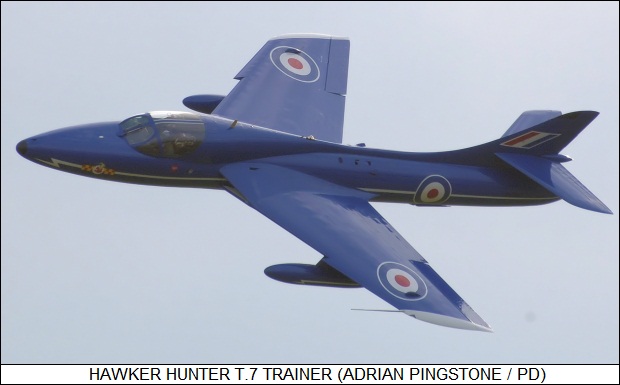
Despite the severity of the modification to turn the single-seat Hunter into a side-by-side trainer, the change arguably did not harm the aircraft's pleasing lines, and apparently did not hurt its performance much, either. The Hunter T.7 was a prominent mount for RAF training squadrons through the 1960s and well into the 1970s, complementing the Folland Gnat T.1. The Gnat was regarded as more agile and its tandem-seat configuration was preferred, at least by students -- but it was too cramped for larger students, and they trained in the Hunter T.7.
Both the Gnat and the Hunter were replaced by the BAE Hawk in the late 1970s. While the Hawk's handling was much better than that of the Hunter T.7, some instructors noted that the more aggressive students did better on the Hunter since it was closer to a real combat aircraft.
As discussed in detail in the next chapter, Hunter trainers were also provided to a number of foreign nations. Among these the Danish "T.53s" were unique, being basically T.7s with the old F.4 wing.
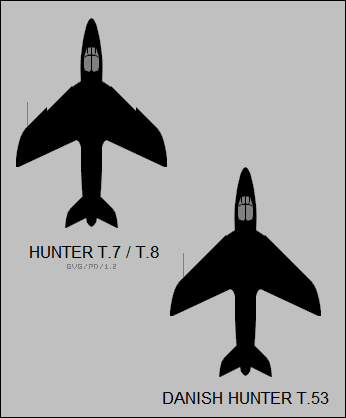
* While the T.7 was going into production, the Royal Navy's FAA decided they were in need of a new trainer to support higher-performance fighters then going into service, such as the de Havilland Sea Vixen and the Supermarine Scimitar. The FAA decided to acquire a variant of the T.7, the "Hunter T.8", to replace Hawker Sea Fury and de Havilland Vampire trainers. Ten of the 55 machines ordered by the RAF were diverted to the FAA, as mentioned above.
The T.8 was very similar to the T.7, but lacked the radio compass and DME (radio distance measuring equipment) gear of the T.7, and was fitted with an arresting hook. The T.8 wasn't stressed to land on a carrier; the arresting hook was meant for practice landings on ground strips fitted up to simulate a carrier deck. To add to confusion, some of the FAA T.8s didn't have the arresting hook while some of the RAF T.7s did, so it isn't an entirely reliable distinguishing feature between the two variants.
An ex-RAF F.4 was converted to serve as the T.8 prototype. Initial service deliveries of the T.8 were in the summer of 1958. Later batches, all converted from ex-RAF F.4s, including:
In the 1970s, three T.8s performed trials of the Ferranti Blue Fox radar for the BAE Sea Harrier navalized "jump jet" fighter. The radar was fitted in a distinct sharp nose. Two of these machines were retained as radar trainers after the Sea Harrier entered service and designated "T.8M".
* The biggest limitation of the T.7 and T.8 was that they used the older Avon 100-series engine and were underpowered. Hawker understood this and built a second P.1011 prototype based on the F.6 with the 200-series engine, with an eye on the export market. The company followed this machine up with another, similar demonstrator, rebuilt from the remains of two F.6s that had crashed. This last machine eventually ended up in Chilean hands as a "T.72".
As detailed later, India was the first to bite on the more powerful trainer variant, ordering their first batches of "T.66" trainers in 1957. Although many other foreign users obtained similar aircraft under various designations, the "T.66" designation is used here for want of a proper label for Hunter trainers with the Avon series-200 engine. The more powerful engine permitted greater take-off weights, and most or all T.66-class trainers were fitted with twin Aden cannon instead of the single cannon of the T.7 / T.8.
* No Hunter T.66s ever ended up in British military service, apparently because of the plentiful supply of F.4s available for conversion to trainers meant there was no strong perceived need to obtain new-build Hunter trainers. One T.66 was built for trials for the BAC TSR.2 strike aircraft. This Hunter was fitted with a modern (by early 1960s standards) cockpit layout and had a bulge on top of its nose. Some sources claim the bulge was to accommodate the kit for the cockpit avionics; others to accommodate a vertical camera in the nose.

The TSR.2 was canceled and this particular Hunter, which was given the unique designation of "T.12", ended up as a trials aircraft for the Royal Aircraft Establishment (RAE) at Farnborough, performing flights with such gear as a "fly-by-wire" flight control system. It lost the bulge in the nose in RAE service, and was much later lost in a take-off accident, on 17 March 1982.
* The Hunter trainers had long service lives. Although some were given camouflage paint schemes, they also sometimes sported high-visibility colors, such as red geometric figures on overall silver, and a few were given very sporty paint jobs. The RAE T.12 featured bright green colors with white on top and a white stripe along the side, while the second Hawker T.66 demonstrator had the same scheme with bright red instead of bright green. Some of the FAA Hunters, apparently those reserved as high-performance hacks for senior officers and called "admiral's barges", were given comparable spiffy paint jobs, such as bright blue on top and white on the bottom.
BACK_TO_TOP* Even as the F.6 was going into the ranks, the RAF was considering what to do with the type once the Lightning went into service and rendered the Hunter obsolete as an interceptor. The service had been using the de Havilland Venom in the close-support role, but it was obsolescent. The obvious thing to do was convert the F.6 to a ground-attack configuration, by reinforcing the wings and improving the stores carriage scheme.
The first of two F.6s to be converted to the ground-attack standard performed its first flight on 3 July 1959, and both prototypes were evaluated in Aden (then a British colony, now part of Yemen). The new variant was given the designation of "Fighter Ground Attack Mark 9 (FGA.9)", and a total of 128 was converted from F.6s for the RAF.
The inner pylon on each wing of the FGA.9 could carry a new 1,044 liter (230 Imperial gallon / 275 US gallon) tank. The flaps had to be "nocked out" to allow flaps to be deployed when the big tanks were fitted. A small brace was added, linking the tank to the wing outboard of the stores pylon to reduce stress on the tank attachment points. The brace prevented the tanks from being jettisoned, but allowed them to be used in combat maneuvers.
Incidentally, there are pictures that survive of a Hunter trainer with overlong 1,589-liter (350 Imperial gallon / 419 US gallon) ferry tanks. It is unclear if these big ferry tanks were strictly trials gear or entered limited service, but in any case the evidence (or more properly the lack of it) suggests they weren't widely used.
The outer pylon could be replaced by four rails for launching 7.62-centimeter (3-inch) "rocket projectiles (RP)", with the RPs mounted in stacks of three to give a total warload of 24 rockets. If the RPs were fitted with the bulbous "60-pounder" warhead, only one could be carried on each rack, for a total of eight. A napalm tank or a bomb with a weight of up to 450 kilograms (1,000 pounds) could in principle be carried on the inner pylon, though of course that meant the 1,044-liter tanks couldn't be carried, and so munitions were rarely carried on the inner pylons.
External warloads had been trialed earlier on F.4s and F.6s, but the FGA.9 was the first variant to carry them operationally. Of course, the FGA.9 retained the four 30-millimeter Aden cannon, which provided plenty of punch for ground attack. The cannon blast deflectors were not fitted, since they were not seen as necessary for a machine that operated at low altitudes in the ground-attack role.
A radio compass was added, the pilot's oxygen supply was increased, the cockpit air-conditioning was uprated, and some other minor changes were made for operations in tropical climates. The "pen-nib" fairing for a brake chute designed for the Hunter trainer was fitted above the engine exhaust to handle the higher landing weight associated with the 1,044-liter tanks. The Avon Mark 207 engine, with 44.7 kN (4,765 kgp / 10,050 lbf) max thrust, was standard, though the first 36 FGA.9s retained the Avon 203 of the F.6 and were re-engined later.
* Later on in the 1960s, the RPs gave way to French-built SNEB / Brandt 68-millimeter (2.68-inch) folding-fin rockets carried in 18-round pods, one on each outer stores pylon, for a total of 36 rockets. FGA.9s were also refitted with the improved Sperry Mark 8S gunsight in 1968. The FGA.9 remained the mainstay of RAF tactical support through the 1960s, but was then replaced by the McDonnell Douglas Phantom, SEPECAT Jaguar, and Hawker Siddeley Harrier vertical take-off strike fighter. The FGA.9 lingered in service as a weapons trainer up to about 1976.
* During 1975 and 1976, 24 old F.6s were also updated to a standard somewhat similar to that of the FGA.9, with the Avon 207 engine and the changes needed for the 1,044-liter tanks, including reinforced inner stores pylons, the nocked-out flaps, and the drag chute. Some sources seem to provide mixed hints that unmodified F.6s also, at least occasionally, carried the big tanks or even that the tanks were introduced before the FGA.9 -- the facts of the matter are unclear. In any case, these machines became "F.6As" and were used for training into the early 1980s.
* In 1956, Hawker began work on a reconnaissance version of the Hunter to replace the increasingly antiquated reconnaissance versions of the Gloster Meteor then in service. The company fitted an F.4 with a five-camera nose to prove the concept; in response the Air Ministry issued a specification designated "FR.164D" for a fighter-reconnaissance machine for the RAF, based on the Hunter F.6.
The first prototype of the Hunter "Fighter Reconnaissance Mark 10 (FR.10)", modified from an F.6, performed its initial flight on 7 November 1959. It retained the four Aden cannon and stores pylons, but the ranging radar was removed and a three-camera nose was fitted that could accommodate one forward and twin oblique cameras. Armor plate was added to the cockpit floor, not merely to reassure the pilot, but as ballast to compensate for the removal of the ranging radar. A cockpit voice recorder was added to allow the pilot to provide a commentary for the photographs. Other changes were as per the FGA.9, including a brake chute compartment, stronger inner pylons and nocked-out flaps for the big ferry tanks, and so on.

First service deliveries of the FR.10 were in 1960. Following the initial FR.10 prototype, 32 more F.6s were converted to the reconnaissance configuration. FR.10s remained in RAF service to the early 1970s, when they were replaced by the Phantom and Harrier.
* The Royal Navy obtained 40 "Ground Attack Mark 11 (GA.11)" advanced weapons trainers beginning in 1962, all of them refurbished conversions of low-flight-time Hunter F.4s. The GA.11s featured a field arresting hook and a TACAN beacon-navigation system. Their Aden cannon were deleted and the muzzle ports faired over, with the radar ranging gunsight deleted as well. All featured dogtooth wings; 16 were fitted with the Mod 228 four-pylon wing. They were wired to carry US-built Bullpup air-to-surface missiles (ASM) and Sidewinder heat-seeking AAMs, but these stores were not carried in practice.

Most or all were fitted with a nose light called a "Harley Light", apparently to make the aircraft easier to spot in training exercises. A handful of the GA.11s were given a camera nose like that of the FR.10 and at least informally designated "Photo Reconnaissance Mark 11 (PR.11)".
Initial flight of the GA.11 was on 24 January 1962. The type served in the first-line training role until 1972, but continued in service in various capacities in the Fleet Requirements & Air Directing Unit (FRADU) at RNAS Yeovilton until 1995.
BACK_TO_TOP* With so many Hunters built, unsurprisingly a number were modified for use in trials and evaluations. The F.1s used for trials and the T.12 have already been mentioned. One F.4 was used in trials of the Fairey "Blue Flash" AAM, which would enter service on the English Electric Lightning fighter as the "Fireflash", and an F.6 was similarly modified for trials of the de Havilland "Blue Jay" AAM, which would enter service as the "Firestreak". Both these machines had modified noses for associated radar kit.
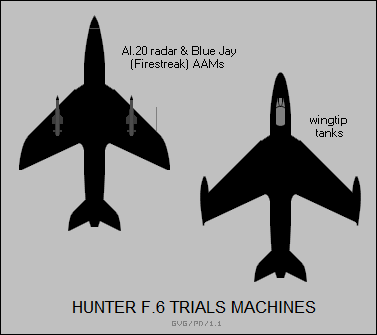
One F.6 was modified for wingtip tanks, a scheme that would have freed the wing pylons for carriage of other stores, but the wingtip tanks led to buffeting and were not adopted. Another F.6 was fitted with a Rolls-Royce thrust reverser in 1956.
Hawkers also proposed a number of variants that were not built. One of the earliest was a true "supersonic Hunter", the "P.1083", which was to have a thin wing with a chord (cross-sectional height to length ratio) of 6% and a sweepback of 50 degrees, as well as an afterburning RA.19R Avon that could provide 55.6 kN (5,670 kgp / 12,500 lbf) afterburning thrust. The single Hunter F.3 with the afterburning RA.7R Avon engine had been a step towards this improved machine, which would have been in a league with the US North American F-100 Super Sabre.

Hawkers also considered other supersonic Hunter designs, including the "P.1090", with a delta wing and an afterburning Sapphire 4 engine; and the considerably modified "P.1091", which featured a 50-degree thin swept wing like that of the P.1083, an afterburning de Havilland Gyron turbojet, a stretched fuselage to accommodate the Gyron, and enlarged intakes to provide adequate engine airflow.
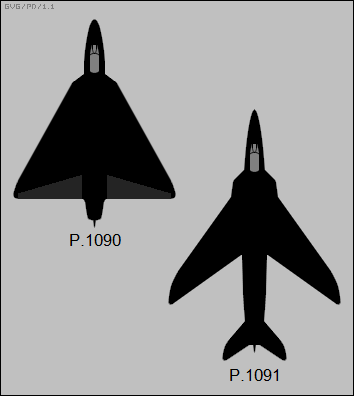
However, aircraft design was advancing rapidly at the time and the powers-that-be decided, not unreasonably, that true Mach 2 fighters were only a few years away and that there was no point in fiddling around with improved Hunters. Although some work was done on a P.1083 prototype, the P.1090 and P.1091 never got beyond the paper stage. Hawkers turned to more limited improvements, fitting the Series-200 Avon to the F.4 to result in the F.6. The center fuselage section of the P.1083 was incorporated into the F.6 to permit fit of the Avon 203 engine. No production Hunter would ever have an afterburning engine.
A number of radar-equipped derivatives of the two-seat Hunter, including the "P.1114", "P.1115", and "P.1130", were also proposed for use in the night / all-weather interceptor role, and there was even a proposal for a business jet, the "P.1128", with side-by-side seating for two aircrew and six passengers. It was to be powered by two small Bristol Orpheus engines.
In the late 1950s, the UK Central Fighter Establishment proposed an advanced Hunter, the "CFE Hunter", which would have had only two cannon but a larger ammunition supply; a non-afterburning Avon 301 powerplant, as used on the Lightning, with 56.3 kN (5,735 kgp / 12,650 lbf) max thrust, or a Rolls-Royce Spey low-bypass turbofan; a fuselage stretch to permit greater fuel load; a drag chute and arresting hook; a new navigation system; and Sidewinder AAM support.
The Swiss, who were enthusiastic Hunter users as is detailed in the next chapter, were offered a similar "Super Hunter" that featured an advanced navigation-attack system and more stores pylons to allow it to carry, for example, eight 450-kilogram (1,000-pound) bombs and two Sidewinders. Nothing came of these advanced Hunter concepts.
BACK_TO_TOP